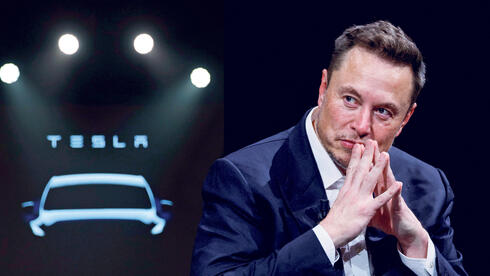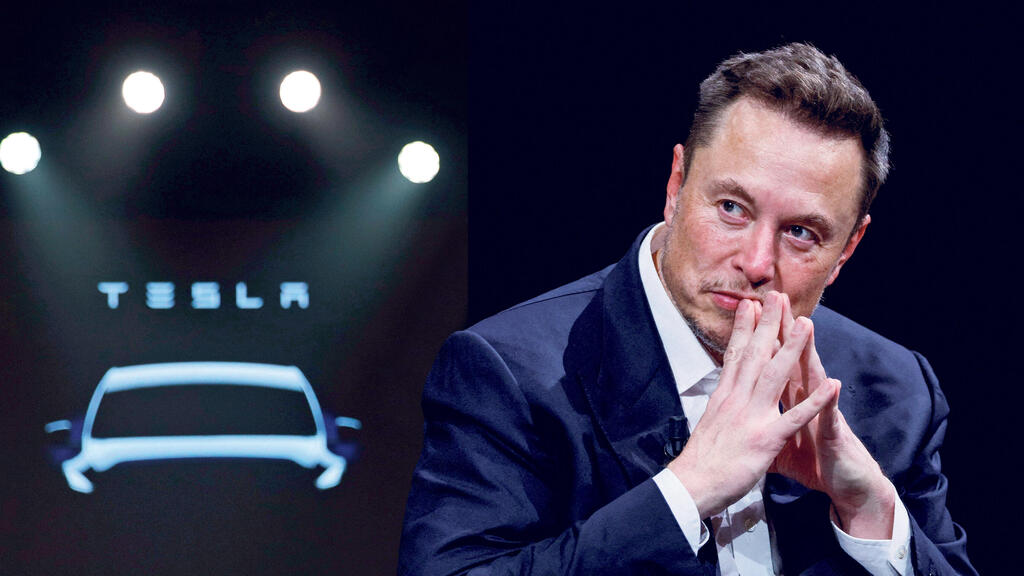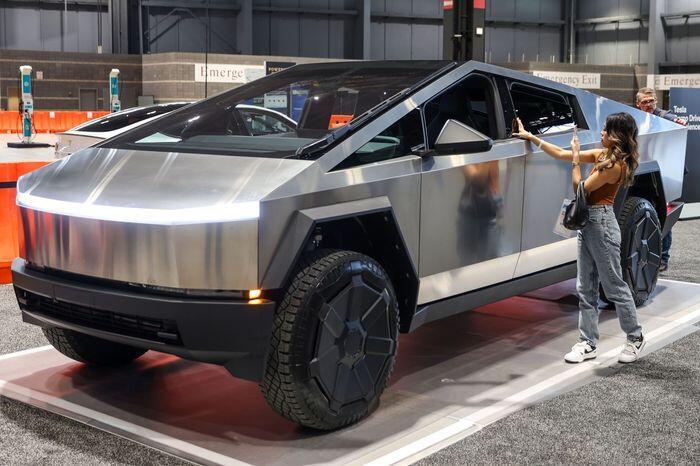
Fork in the road: What's next for Tesla?
In April, the electric vehicle company reported a 9% drop in revenue, a 55% drop in profits, and announced that it would lay off 10% of its employees. In December, it lost the lead in electric vehicle deliveries, and last month it recalled the Cybertruck, its futuristic tank-like vehicle. While the company faces an identity crisis, one fact remains stable: Tesla is Elon Musk, and when he loses focus or interest, so does the company.
The last few months have been especially turbulent for Tesla, the electric vehicle company led by Elon Musk. In December, Tesla lost the global lead in electric vehicle deliveries to the Chinese company BYD. In January, Tesla pessimistically stated that its growth rate this year would be significantly lower than in 2023. In April, rumors surfaced that the company had abandoned its project to manufacture a cheaper model. Additionally, it recalled the Cybertruck, a tank-like vehicle of which only 3,878 units have been delivered since its launch in November, due to a safety issue with the gas pedal. About three weeks ago, Tesla reported a 9% drop in revenues—the largest since 2012—and a 55% drop in profits for the first quarter of the year. The company also reported negative cash flow and announced a 10% reduction in its workforce. Despite these disappointing reports, Tesla's stock jumped by 9% in April.
It is common to discuss Tesla's stock performance, but stock price does not necessarily reflect the company's true condition. Here’s a summary of Tesla’s stock history over the past three years: from early 2020 until November 2021, the stock soared by over 1,000% to a record price of $407 and a market value of $1.2 trillion. Then, it plunged by 70% over the next year to a low of $113. In January 2023, it rebounded, rising by 150% to $281 in June, only to decline again by 35%, reaching $147 about two weeks ago and a market value of $550 billion.
One might think the fall was due to disappointing performance, but Tesla's market value was cut by $600 billion even as it became more profitable, opened two new factories, doubled production and vehicle deliveries, tripled its market share in the United States, and quintupled its global charging facilities. Tesla achieved all this without advertising, with excellent profit margins, and at a time when parts of the car market, especially the American market, were stagnant, delivering fewer cars in 2022 than in 1977.
How can this be explained? There is a disagreement between the company, its managers, and its investors regarding its identity. At times, Tesla is a car manufacturer, other times a technology company, sometimes an artificial intelligence or robotics company, and occasionally an electricity company. Sometimes it represents cutting-edge innovation, and other times it is a car manufacturer that hasn’t announced a new model in almost five years. One day it’s a company with a business model shaping global markets, and the next it’s developing the Cybertruck that cannot be marketed globally due to basic safety standards. Each time a different aspect of its identity is emphasized, and the stock reacts accordingly. The future of Tesla will remain uncertain until it aligns on a clear path.
A car company?
In 2012, Tesla launched the Model S, an electric sports car with a range of over 420 kilometers on a single charge. Though its price was over $57,000, this model changed the electric car market, showing that electric vehicles could be beautiful, interesting, fast, and have a reasonable driving range. Since then, Tesla has launched four more models: Model X, Model 3 sedan, Model Y (a compact version of Model 3), and the Cybertruck.
For many years, Musk stated that Tesla's business strategy was to develop luxury electric cars and use the profits to develop affordable cars for the masses, thereby revolutionizing the automobile market and reducing pollution from gasoline-powered cars. Musk also mentioned that Tesla's main goal was to make him very wealthy so he could colonize Mars. The promise of a cheaper model priced at $25,000 (compared to about $39,900 for the cheapest current model) was crucial for many investors. Many believe this is the only way Tesla can become the best-selling car manufacturer by 2030, an ambition Musk set in 2020. He promised that Tesla would deliver over 20 million vehicles a year—twice the current sales of the world's largest car manufacturer, Toyota. In 2023, Tesla delivered 1.8 million cars, 8% of the target.
Since then, Musk has promised that a cheap model is coming. In January, he reiterated this promise, claiming that production of the new affordable model would begin at a plant in Texas by 2025. In early April, Reuters reported that Musk had temporarily withdrawn from the project. In response, Musk tweeted on X that "Reuters is lying (again)." In a conversation with investors two weeks later, he promised that Tesla would sell cars at a lower price but avoided confirming if it was a new model, effectively confirming Reuters' report. Affordable electric vehicles are still in demand, especially for automakers seeking government subsidies for electric vehicles. Hence, Tesla has made six price cuts this year alone—the latest just before April's earnings reports.
Canceling visible plans for a new and competitively priced model makes Musk's promises to dominate the car market by 2030 impossible. This cancellation also ensures that the goal from nearly two decades ago—that everyone can purchase an electric vehicle—will be achieved by other manufacturers, likely Chinese ones. China, Tesla's second-largest market, saw Tesla's sales fall by 4% in the first quarter of this year, while the local market grew by 15%. If Tesla's goal is no longer to make its vehicles accessible globally, what is its goal?
An electric company?
Tesla is not only a car manufacturer but also a kind of fuel or electricity company. Its supercharger segment grew during 2023, contributing $8.3 billion to the company's annual revenues of $96.8 billion (8.5% of revenues). In April, Musk promised the expansion of this seemingly solid and profitable division. "The division will continue to grow significantly faster than the automotive business," he said. A few days later, the entire charging division, including its senior manager, was laid off—500 employees in total.
Electric vehicles bring a new kind of anxiety: range anxiety. Drivers fear that the battery will run out, leaving them stranded. This concern has been a major obstacle to the widespread adoption of electric vehicles. Car companies, led by Tesla, have addressed this by extending battery life and massively deploying charging stations. The ratio between fast charging points for cars in the United States is one charging station for 75 vehicles, compared to one gas station for 196 combustion vehicles. Despite this, many car owners remain unconvinced due to the relative youth of the technology, the longer charging times compared to refueling, and the smaller number of charging points compared to gas station pumps.
Tesla made the charging business one of its growth engines. Of the 42,000 fast chargers installed in the United States, 25,500 are made by Tesla. The company has a unique charging plug protected by a patent, and last year almost all major car manufacturers selling cars in North America agreed to use Tesla’s charging plug via adapters called Magic Dock found in Tesla's charging stations. Tesla even won $17 million in grants from the U.S. government to support the deployment of charging facilities. In Europe and Israel, most vehicles adhere to a standard charging plug.
The agreement for other car manufacturers to use Tesla’s plug appears to be a beneficial move, making its charging facilities a de facto standard. However, this also allows competitors to challenge Tesla more aggressively. The reasoning behind withdrawing from this profitable activity is unclear, apart from Musk’s announcement that the company is laying off, slowing down, canceling, and cutting from all sides to be “hardcore focused” on its core activity. But if developing a new affordable model is not part of the core activity, what is?
An artificial intelligence company?
In a conversation with investors, Musk explained that the company encountered "unexpected challenges" regarding shrinking profits and falling sales. He casually dismissed the importance of not moving forward with the development of cheaper models, instead focusing on advancing the robotics idea. The autonomous taxi already has an unveiling date: August 8. Musk clarified the company’s mission: “We need to be treated as an AI or robotics company. If you value Tesla just as a car company... fundamentally, that’s just the wrong framework,” emphasizing the amount of processors the company is buying to support its AI ambitions.
Many companies have explored autonomous taxis, but most, including Uber, Lyft, and Apple, have abandoned these projects due to their difficulty. The problem is also challenging for Tesla, though Musk repeatedly assures that the transformation is imminent. In 2016, he claimed Teslas could drive autonomously. In 2019, he promised that by 2020 there would be a million self-driving Teslas in the U.S., including a fleet of autonomous taxis, and that mass production would start by 2024. None of this has happened.
Following broken promises, Musk shifted focus to the “automaker” aspect in 2020. “Tesla sales are growing faster than Henry Ford's Model T,” he said. Emphasizing production made sense—this core activity is responsible for 80% of the company’s revenues. But what happens when the core business shows disappointing results, as in the first quarter of 2024, when profits fell by 55%, deliveries by 8%, revenue by 13%, and profit margins from 19% to 16%? The tone must change again: “If someone doesn’t believe that Tesla will solve autonomy, I think he shouldn’t be an investor in the company,” Musk said recently.
Musk’s emphasis on autonomous vehicles comes in waves—sometimes interesting, sometimes capricious, but often hasty and unsafe. Tesla’s self-driving features have been linked to hundreds of accidents, some fatal. An April report by the National Highway Traffic Safety Administration (NHTSA) stated that Tesla is “an exception in the industry” in the number of accidents, partly due to lacking basic precautions. According to the report, in at least half of the 109 head-on accidents examined, a Tesla vehicle collided with an obstacle directly in front of it at least five seconds before impact—time enough for any alert driver to avoid serious injury. The administration criticized Tesla’s naming of its driving software, such as “autopilot” and “fully autonomous driving,” as misleading and dangerous, unlike the more cautious terminology used by other manufacturers.
Tesla has defended itself in court against accusations of misleading consumers about the safety of its Autopilot software, creating an excessive sense of security in drivers. Despite this, Musk remains undeterred. Even if autonomous driving is a difficult problem and Tesla's products are dangerous for private consumers, he still plans to move ahead with public transportation.
Tesla must decide its identity: as a car manufacturer aiming for global market share, it must offer new and affordable models; as a relatively prestigious brand, it must stop claiming it will be the largest car manufacturer in five years; or as an AI company, it must develop responsible products for mass use. Until Tesla decides, its stock will be as capricious as its CEO, who faces scrutiny in June over his demand for a $55 billion salary package.
While Tesla grapples with an identity crisis, one fact remains stable: Tesla is Elon Musk. When he invests time in its management, he can turn it into one of the world’s most recognized electric vehicle manufacturers. When he loses focus, the company falters.















